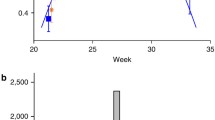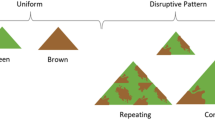Abstract
It is not clear which selective pressures balance the strong fecundity advantage associated with large female body size in insects. A positively size-dependent mortality risk could provide a solution. In aviary experiments with artificial larvae, we studied if larger larvae of folivorous insects are more readily found (= detectability) and/or attacked (= acceptability) by birds. As size and colouration are likely to interact in determining birds’ responses, both cryptic and conspicuous prey items were used. As detectability is likely to be context-dependent, both simple (smooth) and complex (plants) backgrounds were used in respective experiments. In the conspicuous larvae, acceptability correlated negatively with prey size. However, their detectability was context dependent, being positively correlated with size on the simple background, whereas no significant effect was found on the complex background. Surprisingly, cryptic larvae showed no correlation between detectability and size, and there was only a weak tendency for birds to attack large larvae more readily. On the basis of a quantitative model, we conclude that the effect of positively size dependent bird predation, as a single factor, is not likely to counterbalance the fecundity advantage in cryptic species, and may thus not be crucial in determining the optimum for body sizes in these insects. In conspicuous species, there is a potential for different outcomes, because detectability and acceptability affect survival in different directions. The net outcome is, therefore, likely to be highly context-dependent. Furthermore, our results provide an explanation for the recently reported absence of systematic body-size differences between cryptic and conspicuous Lepidopteran larvae: although conspicuous larvae benefit from increasing their warning signal when growing larger, they also suffer a much sharper rise in detectability.


Similar content being viewed by others
References
Baker RR (1970) Bird predation as a selective pressure on the immature stages of the cabbage butterflies, Pieris rapae and P. brassicae. J Zool Lond 162:43–59
Bernays EA, Singer M (2002) Contrasting foraging tactics in two species of polyphagous caterpillars. Acta Zool Acad Sci Hung 48:117–135
Blanckenhorn WU (2000) The evolution of body size: what keeps organisms small? Q Rev Biol 75:385–407
Church SC, Jowers M, Allen JA (1997) Does prey dispersion affect frequency-dependent predation by wild birds? Oecologia 111:292–296
Cogni R, Freitas AVL, Filho BFA (2002) Influence of prey size on predation success by Zelus longipes L. (Het., Reduviidae). J Appl Entomol 126:74–78
Cornell HV, Hawkins BA (1995) Survival patterns and mortality sources of herbivorous insects: Some demographic trends. Am Nat 145:563–593
Dempster JP (1984) The natural enemies of butterflies. In: The biology of butterflies: symposium of the Royal Society of London, vol 11. Academic, London, pp 97–104
Dyer LA (1995) Tasty generalists and nasty specialists? A comparative study of antipredator mechanisms in tropical lepidopteran larvae. Ecology 76:1483–1496
Endler JA (1978) A predator’s view of animal color patterns. Evol Biol 11:319–364
Endler JA (1986) Natural selection in the wild. Princeton University Press, Princeton
Endler JA (1988) Frequency-dependent predation, crypsis and aposematic coloration. Phil Trans R Soc Lond B 319:505–523
Endler JA, Mappes J (2004) Predator mixes and the conspicuousness of aposematic signals. Am Nat 163:532–547
Esperk T, Tammaru T (2004) Does the “investment principle” model explain moulting strategies in Lepidopteran larvae? Physiol Entomol 29:56–66
Forsman A, Merilaita S (1999) Fearful symmetry: pattern size and asymmetry affects aposematic signal efficacy. Evol Ecol 13:131–140
Gamberale G, Tullberg BS (1996) Evidence for a peak-shift in predator generalization among aposematic prey. Proc R Soc Lond B 263:1329–1334
Gamberale G, Tullberg BS (1998) Aposematism and gregariousness: the combined effect of group size and colouration on signal repellence. Proc R Soc Lond B 265:889–894
Grieco F (2002) Time constraint on food choice in provisioning blue tits, Parus caeruleus: the relationship between feeding rate and prey size. Anim Behav 64:517–526
Gotthard K (2004) Growth strategies and optimal body size in temperate Pararginii butterflies. Integr Comp Biol 44:471–479
Grushecky ST, Liebhold AM, Greer R, Smith RL (1998) Does forest thinning affect predation on gypsy moth (Lepidoptera: Lymantriidae) larvae and pupae? Environ Entomol 27:268–276
Hagman M, Forsman A (2003) Correlated evolution of conspicuous coloration and body size in poison frogs (Dendrobatidae). Evolution 57:2904–2910
Henry CJ, Day KR (2001) Egg allocation by Bracon hylobii Ratz., the principal parasitoid of the large pine weevil (Hylobius abietis L.), and implications for host suppression. Agric Forest Entomol 3:11–18
Honěk A (1993) Intraspecific variation in body size and fecundity in insects: a general relationship. Oikos 66:483–492
Hunter AF (2000) Gregariousness and repellent defences in the survival of phytophagous insects. Oikos 91:213–224
Leimar O (1996) Life history plasticity: influence of fotoperiod on growth and development in the common blue butterfly. Oikos 76:228–243
Lindström L, Alatalo RV, Mappes J (1999a) Reactions of hand-reared and wild-caught predators toward warningly colored, gregarious, and conspicuous prey. Behav Ecol 10:317–322
Lindström L, Alatalo RV, Mappes J, Riipi M, Vertainen L (1999b) Can aposematic signals evolve by gradual change? Nature 397:249–251
Lindström L, Rowe C, Guilford T (2001) Pyrazine odour makes visually conspicuous prey aversive. Proc Roy Soc Lond B 268:159–162
Littell RC, Milliken GA, Stroup WW, Wolfinger RD (1996) SAS System for mixed models. SAS Institute, Cary
Littell RC, Stroup WW, Freund JR (2002) SAS for linear models, 4th edn. SAS Institute Inc, Cary
Mappes J, Alatalo RV (1997) Effects of novelty and gregariousness in survival of aposematic prey. Behav Ecol 8:174–177
Mappes J, Marples N, Endler JA (2005) The complex business of survival by aposematism. Trends Ecol Evol (in press)
Marples NM, Roper TJ (1996) Effects of novel colour and smell on the response of naive chicks towards food and water. Anim Behav 51:1417–1424
Marples NM, Kelly DJ, Thomas RJ (2005) Perspective: the evolution of warning coloration is not paradoxical. Evolution 59:933–940
Merilaita S, Lyytinen A, Mappes J (2001) Selection for cryptic coloration in a visually heterogeneous habitat. Proc R Soc Lond B 268:1–5
Myers JH, Smith JNM (1978) Head flicking by tent caterpillars: a defensive response to parasite sounds. Can J Zool 56:1628–1631
Nilsson M, Forsman A (2003) Evolution of conspicuous colouration, body size and gregariousness: a comparative analysis of lepidopteran larvae. Evol Ecol 17:51–66
Niskanen M, Mappes J (2005) Significance of the dorsal zigzag pattern of Vipera latastei gaditana against avian predators. J Anim Ecol 74:1091–1101
Oliveira FB (2005) Body-size influence on defensive behaviour of Amazonian moths: an ecophysiological approach. Braz J boil 65:101–106
Poulton EB (1890) The colours of animals. Their meaning and use. Especially considered in the case of insects. Kegan Paul, Trench, Trübner and Co. Ltd, London
Riipi M, Alatalo RV, Lindström L, Mappes J (2001) Multiple benefits of gregariousness cover detectability costs in aposematic aggregations. Nature 413:512–514
Roff DA (1992) The evolution of life histories. Chapman and Hall, New York
Rowe CL, Guilford T (1996) Hidden colour aversions of domestic chicks triggered by pyrazine odours of insect warning displays. Nature 383:520–522
Schuler W, Hesse E (1985) On the function of warning colouration: a black and yellow pattern inhibits prey-attack by naļve domestic chicks. Behav Ecol Sociobiol 16:249–255
Stearns SC (1992) The evolution of life histories. Oxford University Press, Oxford
Tammaru T, Haukioja E (1996) Capital breeders and income breeders among Lepidoptera: consequences to population dynamics. Oikos 77:561–564
Tammaru T, Kaitaniemi P, Ruohomäki K (1996) Realized fecundity in Epirrita autumnata (Lepidoptera, Geometridae): relation to body size and consequences to population dynamics. Oikos 77:407–416
Tammaru T (1998) Determination of adult size in a folivorous moth: constraints at instar level? Ecol Entomol 23:80–89
Tammaru T, Esperk T, Castellanos I (2002) No evidence for costs of being large in females of Orgyia spp. (Lepidoptera, Lymantriidae): larger is always better. Oecologia 133:430–438
Teder T, Tammaru T (2001) Larger larvae of a flush-feeding moth are not at a higher parasitism risk: implications for host life-history. Eur J Entomol 98:277–282
Tullberg BS Merilaita S, Wiklund C (2005) Aposematism and crypsis combined as a result of distance dependence: functional versatility of the colour pattern in the wallowtail butterfly larva. Proc R Soc B 272:1315–1321
Varley GC, Gradwell GR, Hassell MP (1973) Insect population ecology: an analytical approach. Blackwell, Oxford
Vermeij GJ (1982) Unsuccessful predation and evolution. Am Nat 120:701–720
Weseloh RM (1990) Estimation of predation rates of gypsy moth larvae by exposure of tethered caterpillars. Environ Entomol 19:448–455
Zaviezo T, Mills NJ (2000) Factors influencing the evolution of clutch size in a gregarious insect parasitoid. J Anim Ecol 69:1047–1057
Acknowledgments
We thank Wolf Blanckenhorn, John Endler, Peeter Hõrak, Lauri Saks, and the anonymous referees for their comments on the manuscript. We are also grateful to the members of Nigula Nature Reserve administration, especially Agu Leivits, and several voluntary assistants at Kabli Bird Station, as well as Helinä Nisu and the staff at Konnevesi Research Station for assistance in technical issues. The study was financed by Estonian Science Foundation grant # 5746, and the Centre for International Mobility (Finland).
Author information
Authors and Affiliations
Corresponding author
Additional information
Estonian Science Foundation grant # 5746; Centre for International Mobility (Finland).
Rights and permissions
About this article
Cite this article
Mänd, T., Tammaru, T. & Mappes, J. Size dependent predation risk in cryptic and conspicuous insects. Evol Ecol 21, 485–498 (2007). https://doi.org/10.1007/s10682-006-9130-z
Received:
Accepted:
Published:
Issue Date:
DOI: https://doi.org/10.1007/s10682-006-9130-z




